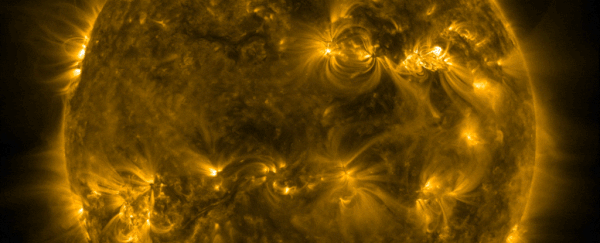An active sunspot region on the Sun has been going hardcore: on 31 March at 17:27 UT, AR2975 erupted in the most powerful class of flare of which our Sun is capable, an X-class clocking in at X1.3.
It's the most powerful of a series of flares emitted by the region. At time of writing, AR2975 has emitted 36 flares: one small B-class flare, 29 middling C-class flares, 9 of the more powerful M-class flares, and this one X-class monster.
Each class of flares is ten times more powerful than the previous, with multiple grades within the class. The most powerful flare on record ever to lash Earth was an X28 flare that took place in November 2003.
When solar flares, and their associated coronal mass ejections (CMEs) are unleashed in the general direction of Earth, shenanigans can ensue. A massive belch of solar particles is launched into interplanetary space; when these particles collide with Earth's magnetic field and atmosphere, geomagnetic storms are triggered.
 X-class flare emerging from AR2975. (NASA SDO)
X-class flare emerging from AR2975. (NASA SDO)
Mostly, these will go more or less unnoticed by us lowly surface-dwellers. They can cause some radio and navigation blackouts, maybe some power grid fluctuations, and spectacular aurorae lighting up the polar skies as particles, accelerated along Earth's magnetic field lines, are deposited at the poles, where they interact with the atmosphere.
Case in point: a massive CME associated with two of AR2975's M-class flares should have arrived at Earth in the last few days, triggering a strong geomagnetic storm. Unless you were out taking pictures of auroras, you probably didn't notice much of anything.
The X-class flare, and the subsequent powerful M9 flare, emitted by AR2975 did indeed take place on the Earth-facing side of the Sun, but that's not a guarantee of geomagnetic storms. The region is currently rotating away from Earth, and any solar particles launched into space may deliver just a glancing blow.
As unnamed NOAA analysts are quoted by Spaceweather: "The CME associated with the X1 flare was modeled and is unlikely to have any significant Earth impacts." Nevertheless, the chance of aurora is high over the first few days of April.
 The X-ray emission associated with the X-class flare. (NASA SDO)
The X-ray emission associated with the X-class flare. (NASA SDO)
If you think you've been hearing a lot about the Sun's restlessness lately, you're not wrong. Our star has been super rowdy, with eruptions every day since mid-January, and a lot of activity prior to then. This is pretty normal. The Sun goes through activity cycles every 11 years, with a clearly defined minimum (with minimal sunspot and flare activity) and maximum.
The magnetic field flips, with the solar poles switching places, during the peak of the solar maximum. From that point, the magnetic field grows weaker, and sunspot and flare activity decreases.
Since the most recent solar minimum took place in December 2019, we're currently seeing escalating activity. Previous solar cycles show similar levels of activity at the same stage.
Solar maximum is due to take place sometime around July 2025, and we have unprecedented eyes on the Sun. The European Space Agency's Solar Orbiter and NASA's Parker Solar Probe are currently getting very up close and personal with our star, closer than any probe has ever been. With solar maximum looming, we are expecting to gain some breathtaking insight into why the Sun behaves the way it does.
